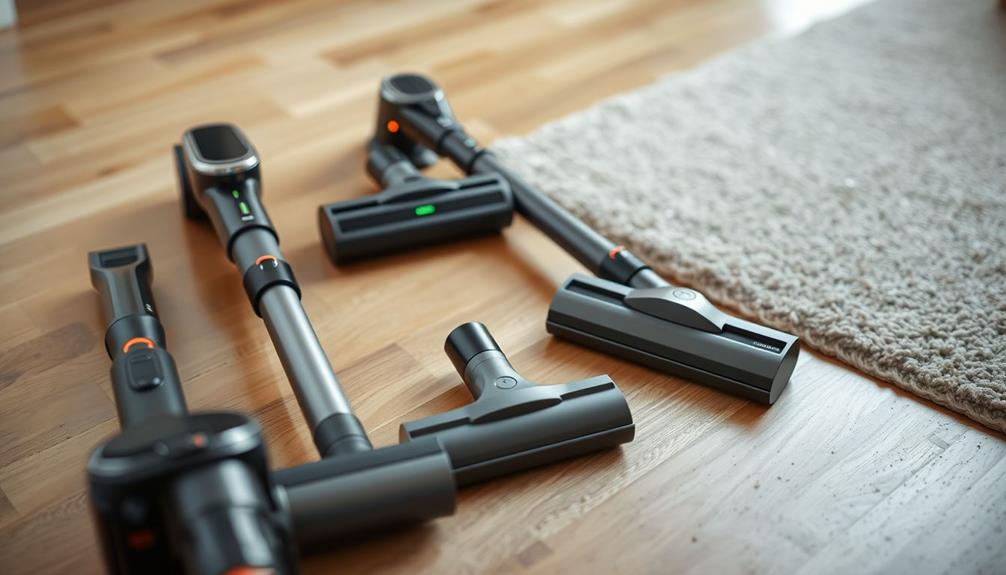To comprehend the performance of a vacuum cleaner, one should pay attention to airflow and water lift. Airflow, typically measured in CFM, should ideally fall between 150-300 for effective cleaning, while water lift, measured in inches of water column, should range from 80-120 inches. Increased airflow boosts suction power, which is crucial for efficiently capturing dirt and dust. By maintaining these measurements, you can enhance air quality, safety, and productivity in your work area. It is vital to regularly maintain your vacuum to ensure it operates at its peak performance. If you are interested in learning more about how these specifications impact various cleaning tasks, there is a wealth of information to discover about vacuum technology.
Key Takeaways
- Airflow, measured in CFM, is crucial for vacuum performance; ideal ranges are 150-300 CFM for effective cleaning.
- Water lift indicates suction strength, with an effective range of 80-120 inches for optimal surface preparation.
- Balancing airflow and water lift ensures efficient dirt pickup and minimizes health risks from airborne particles.
- Regular maintenance of filters and vacuum systems sustains performance and air quality in cleaning environments.
- User-friendly vacuum designs improve the cleaning experience with features like lightweight construction and ergonomic handles.
Importance of Airflow
Airflow is an important metric in vacuum cleaner performance that you can't overlook. It's measured in cubic feet per minute (CFM) and plays a fundamental role in your vacuum's cleaning performance. For surface preparation vacuums, achieving ideal airflow between 150-300 CFM means you can effectively capture dust and debris.
Additionally, some vacuums, like the BISSELL CleanView Swivel Upright, provide budget-friendly options that still maintain impressive airflow, which is vital for effective cleaning.
High airflow is essential for quickly collecting large volumes of air, which greatly enhances suction power. In industrial settings, this is particularly important, as it helps remove fine silica dust generated during concrete grinding. By capturing this dust before it becomes airborne, you protect worker health and boost overall safety.
The effectiveness of your vacuum largely hinges on its airflow capabilities. For canisters, aim for at least 100 CFM, while uprights should perform at 60 CFM or better.
Maintaining high airflow not only guarantees sustained suction over large surfaces but also improves productivity by reducing cleanup time in environments like warehouses and factories.
In short, a strong airflow contributes to a more efficient filtration system and a cleaner workspace, making it a vital factor in vacuum selection and performance.
Understanding Water Lift
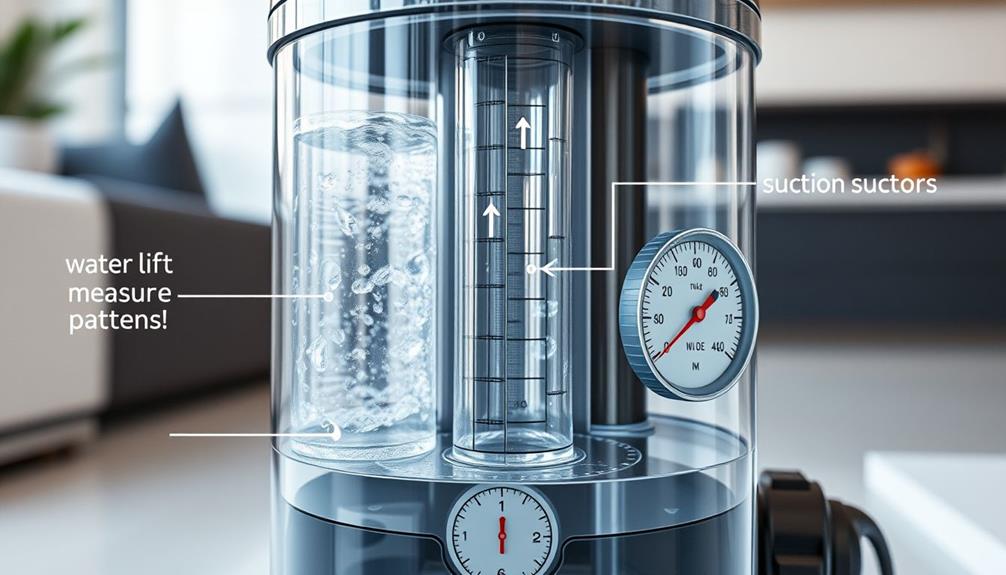
Understanding water lift is an important performance metric that directly impacts your vacuum cleaner's ability to manage heavier debris and liquids. Measured in inches of water column (inH2O) or millibars (mbar), higher water lift values indicate greater suction strength, enabling efficient cleaning.
For effective surface preparation vacuums, an ideal water lift range is between 80-120 inches. This range is significant for removing dust and debris from various surfaces, and proper appliance maintenance can further enhance performance.
When using HEPA filters, you need to evaluate water lift carefully. These filters have higher resistance due to their fine filtration capabilities, which can affect your vacuum's overall cleaning ability. Achieving a balance between water lift and airflow (CFM) is crucial for maintaining ideal performance.
If water lift is excessively high, it might hinder tasks like shot blasting, where controlled suction is necessary.
Understanding water lift helps you select the right vacuum for your needs, ensuring you can tackle both lighter debris and heavier liquids. By assessing this metric alongside airflow, you'll enhance your vacuum's efficiency and effectiveness in various industrial and commercial applications.
Ideal Specifications for Vacuums

When choosing a vacuum, you need to take into account the ideal airflow and water lift ranges.
Ideally, vacuums designed for pet owners, like the Bissell Pet Hair Eraser Vacuum, feature enhanced suction power to effectively tackle pet hair.
Aim for airflow between 150-300 CFM to efficiently tackle dust and debris, while a water lift of 80-120 inches will help with heavier materials.
Balancing these specifications is key to achieving the best cleaning performance.
Optimal Airflow Requirements
Effective vacuum performance hinges on ideal airflow requirements, which play an essential role in achieving thorough dust and debris removal. To guarantee you meet your cleaning needs, consider these key factors:
- Ideal Airflow Range: Aim for 150-300 cubic feet per minute (CFM) for effective surface prep vacuums. Additionally, maintaining a clean environment around your vacuum can enhance its performance, similar to how air purifiers improve air quality through ideal positioning and airflow.
- Suction Power Balance: A well-balanced airflow supports sustained suction over large areas, vital for capturing fine particles.
- High Airflow Importance: For tasks like concrete grinding, high airflow is significant to enhance worker safety by capturing airborne dust.
- Regular Maintenance: Keep your vacuum in top shape to maintain airflow efficiency and prolong dust extraction capabilities.
Selecting vacuums with high airflow specifications not only improves vacuum performance but also contributes to a cleaner work environment.
By focusing on ideal airflow, you can effectively enhance dust control and boost overall productivity.
Always remember that maintaining this airflow is key to maximizing suction power and efficiency, guaranteeing your vacuum meets the demands of any task you tackle.
Effective Water Lift Range
To achieve peak vacuum performance, you should focus on the ideal water lift range, which falls between 80 to 120 inches. This range guarantees your vacuum has powerful suction capabilities, vital for effectively handling both light and heavy debris.
Higher water lift values indicate stronger suction, particularly important for cleaning applications involving heavier materials or liquids. In the context of pool maintenance, robotic vacuums like the WYBOT A1 model exemplify how effective suction can enhance cleaning efficiency.
However, it's essential to balance water lift with airflow. If the water lift is too high, it may restrict airflow, negatively impacting the vacuum's overall cleaning efficiency. Vacuums designed for specific tasks, like surface preparation, often require water lift values within this range to guarantee effective dust extraction during processes such as concrete grinding.
Using a vacuum with ideal water lift not only enhances cleaning efficiency but also improves safety and cleanliness in your work environment. By effectively capturing fine dust and debris before it becomes airborne, you can maintain a healthier space.
Impact on Work Environment
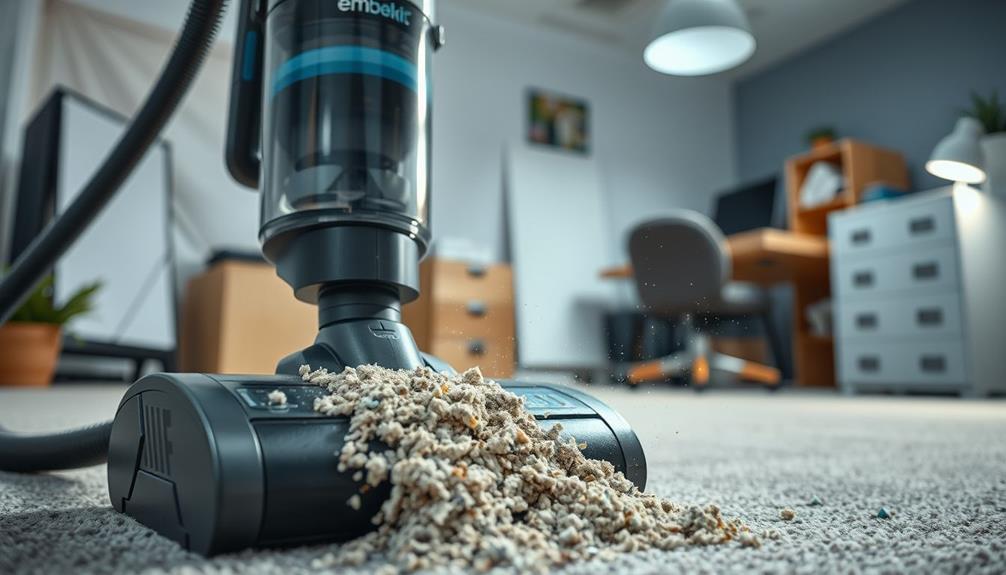
When you maintain cleaner workspaces, you greatly enhance safety and improve air quality standards.
Efficient vacuum systems not only reduce cleanup time but also minimize health risks associated with dust exposure.
Investing in a quality vacuum can be a part of a larger strategy to guarantee a what to look for in a home cleaning service that prioritizes cleanliness and safety.
As a result, you create a more productive and satisfying work environment for everyone involved.
Cleaner Workspaces Enhance Safety
A cleaner workspace can greatly boost safety and efficiency in any environment. Consider these benefits of effective vacuum cleaners:
- Enhanced dust control: High suction power and an efficient filtration system capture harmful particles before they become airborne, similar to the way optimal temperatures for cooking can enhance food safety and quality.
- Improved health: By reducing exposure to silica dust, you minimize respiratory issues among workers.
- Reduced cleanup time: A thorough cleaning process allows you to focus on tasks without the distraction of dust and debris.
- Optimized performance: Balanced airflow and water lift improve project outcomes, guaranteeing a safer and more organized work environment.
When you maintain a cleaner workspace, cleaner air continues to circulate, promoting not just safety but also productivity.
The right vacuum with an effective filtration system helps achieve this by efficiently extracting dust during high-risk tasks.
Regular maintenance of your vacuum guarantees it operates at peak performance, further mitigating dust hazards.
Ultimately, investing in powerful vacuums enhances both safety and efficiency, creating a work environment that supports worker health and maximizes output.
Improved Air Quality Standards
Maintaining a clean workspace not only boosts safety and productivity but also plays an important role in enhancing air quality. Effective cleaning through vacuum systems equipped with high-efficiency particulate air (HEPA) filters greatly reduces airborne dust and allergens.
In addition, incorporating practices such as self-awareness techniques can further contribute to a healthier work environment by promoting mindfulness and reducing stress. By utilizing vacuums with ideal airflow—between 150-300 CFM—and water lift capabilities of 80-120 inches, you can achieve superior dust extraction, especially during tasks like concrete grinding.
These metrics not only guarantee that your workspace remains free from harmful particulates but also protect your health. The HEPA filters capture microscopic dust, preventing respiratory issues caused by airborne contaminants.
Regular maintenance of your vacuum systems is vital; cleaning and replacing filters will sustain air quality and prevent harmful dust accumulation.
When you prioritize air quality by implementing advanced filtration systems, you promote long-term health benefits for everyone in the work environment. This results in fewer dust-related illnesses and boosts overall productivity.
Reduced Cleanup Time Efficiency
Reducing cleanup time is vital for maintaining an efficient work environment, especially in industrial settings. The right tools can greatly impact this efficiency, making it essential to invest in high-performance equipment like garage door openers that enhance overall security.
Here are four key factors that enhance your vacuum's performance and minimize cleanup time:
- High Airflow: A vacuum with airflow between 150-300 CFM captures dust and debris quickly.
- Effective Water Lift: With water lift capabilities of 80-120 inches, vacuums can handle heavier debris and liquids, reducing the need for multiple passes.
- High Filtration: Utilizing HEPA filtration guarantees effective dust control, preventing airborne particles and improving air quality.
- Powerful Suction: Improved suction power enhances overall cleanliness, minimizing maintenance time.
Equipment and Maintenance Considerations
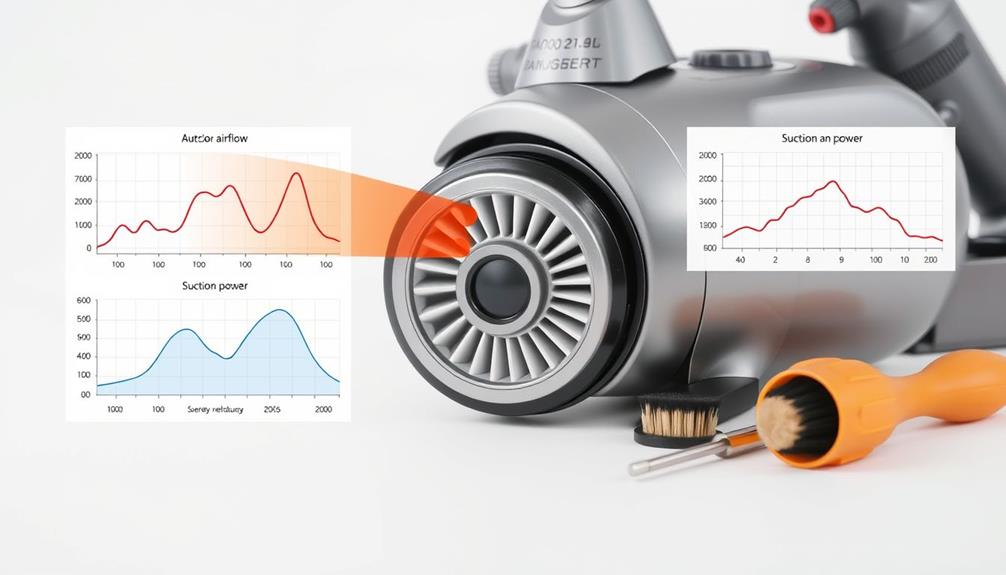
To keep your vacuum cleaner running at peak performance, regular equipment maintenance is vital. You should routinely clean or replace filters, as this plays a notable role in sustaining ideal airflow and vacuum suction.
Using well-draining soil for your plants can be similar to guaranteeing your vacuum has unobstructed airflow; both are essential for ideal performance. If you ignore blockages, you'll notice a drop in performance metrics, making your cleaning sessions less efficient.
When selecting dust extractors for industrial settings, verify they meet specified performance metrics like ideal airflow (150-300 CFM) and water lift (80-120 inches). These metrics are essential for effective dust and debris removal.
Additionally, consider upgrading to HEPA filtration systems to maintain high air quality, especially in environments where allergens and fine dust are prevalent.
Ergonomics also matter; using specialized attachments can enhance usability and help you reach difficult areas more easily.
Finally, choose vacuum equipment designed for ease of maintenance. Features like easily accessible filters and onboard tool storage can greatly improve your user experience and operational productivity.
Primary and Secondary Specifications
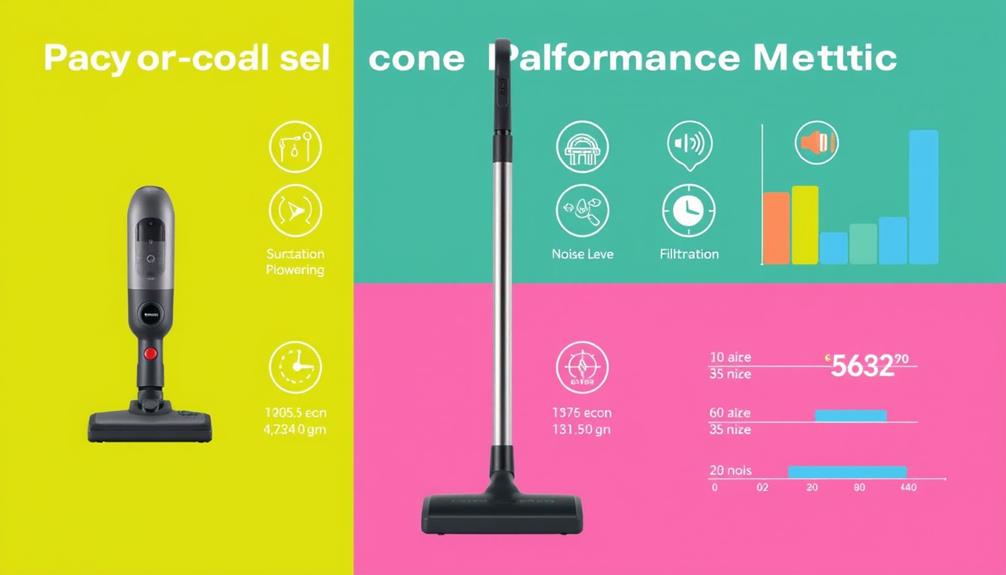
When considering vacuum cleaners, understanding primary and secondary specifications is significant for making an informed choice. Here are four key metrics to evaluate:
- Suction Power: Measured in water lift, this indicates the vacuum's ability to lift dirt and debris.
- Airflow: Measured in CFM (cubic feet per minute), efficient models typically have 100 CFM or more for canisters and 60 CFM for uprights.
- Filtration Systems: Look for HEPA filters for efficient dust capture, but remember they might restrict airflow, affecting overall suction power.
- Horsepower and Watts: These specifications help gauge the vacuum's power and performance capabilities.
Understanding these primary specifications helps you assess a vacuum's cleaning ability. Higher water lift values mean better performance for heavy-duty tasks, while adequate airflow guarantees efficient dirt pickup.
Secondary specifications, such as dust container capacity and noise levels, also play a significant role in the user experience. Balancing suction power, airflow, and filtration effectiveness is essential for peak performance metrics.
Features Affecting User Experience
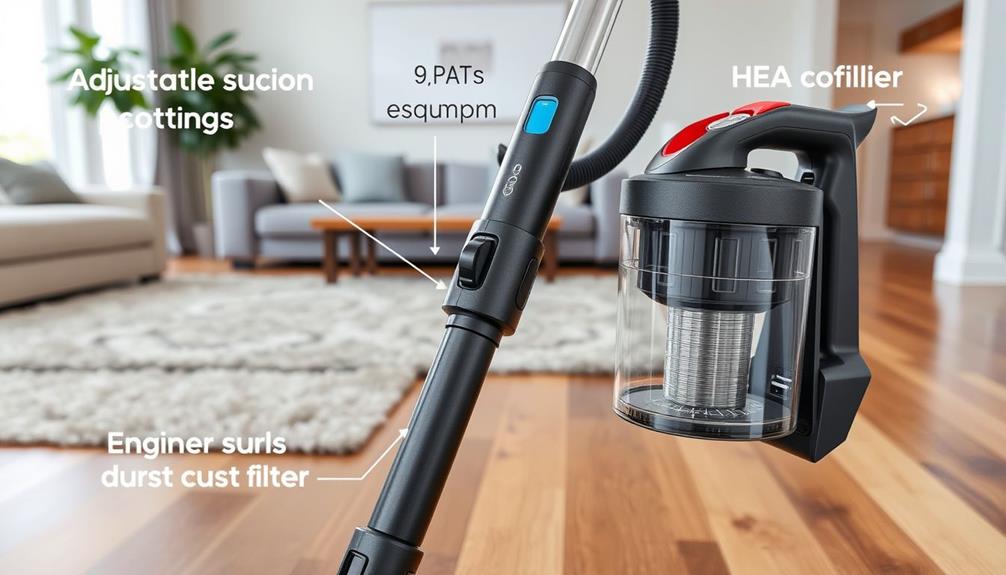
Several features notably impact your experience with a vacuum cleaner, making it essential to take them into account alongside performance metrics. User-friendly designs, such as lightweight construction and ergonomic handles, make maneuvering during cleaning tasks much easier.
You'll appreciate vacuums with intuitive controls and on-board tool storage, as they allow you to switch between attachments quickly and efficiently.
Noise levels are another vital consideration. High-quality vacuums typically operate in the mid-60s dB range, providing a more comfortable cleaning experience compared to those traditional models that can be considerably louder.
If you value freedom of movement, a cordless vacuum is a fantastic option, letting you clean without the hassle of a tangled cord.
Don't overlook advanced filtration systems like HEPA filters. While they effectively trap allergens and enhance air quality, they also require regular maintenance, which can impact your overall experience.
Features like automatic emptying and app compatibility can streamline this process, making upkeep much more convenient.
Frequently Asked Questions
How Do You Measure Vacuum Cleaner Performance?
To measure vacuum cleaner performance, you'll want to look at airflow and suction power.
Airflow is measured in cubic feet per minute (CFM), while suction power is indicated in inches of water lift (inH2O).
Ideally, effective vacuums should have airflow around 100 CFM and suction between 80-120 inches.
Don't forget to take into account power consumption and filtration systems, as they can also impact overall cleaning efficiency and air quality during use.
What Determines the Suction Power of a Vacuum Cleaner?
When you're shopping for a vacuum, think about how a higher wattage motor can boost suction power.
It's not just about watts, though; effective suction also comes from air pressure measured in pascals and airflow in cubic feet per minute.
For instance, a vacuum with 25,000 Pa can tackle stubborn dirt effectively.
Plus, the design of the suction head and hose plays an essential role in maintaining consistent performance during your cleaning tasks.
How to Tell if a Vacuum Cleaner Has Good Suction?
To tell if a vacuum cleaner has good suction, check its water lift measurement—ideally between 80 to 120 inches.
Look at the airflow; a decent vacuum should have at least 100 CFM for canister models or 60 CFM for uprights.
Higher wattage often means better suction, so aim for 600 to 2000 watts for home use.
How to Calculate Suction Power of Vacuum Cleaner?
To calculate your vacuum cleaner's suction power, take a model with an airflow of 100 CFM and a lift of 80 inches.
You'd use the formula: (100 x 80) / 8.5, which gives you approximately 941 air watts.
This means you can gauge its effectiveness in cleaning.
Just remember, higher wattage often means better suction, but always check independent test results to verify accuracy and avoid marketing hype.
Conclusion
To sum up, grasping the science of suction can transform your cleaning experience. Did you know that a vacuum's airflow is typically measured in cubic feet per minute (CFM), and a powerful vacuum can reach over 100 CFM? That means more dirt and debris gets picked up faster, saving you time and effort. By understanding these performance metrics, you can choose the right vacuum for your needs, ensuring a cleaner, healthier space without the hassle. When considering the right vacuum for your needs, it’s also important to take into account the noise levels of vacuum cleaners. Some vacuums can be quite loud, which may not be suitable for households with sleeping children or pets. Fortunately, many manufacturers now offer quieter models that still deliver powerful suction. By evaluating both airflow and noise levels, you can make an informed decision that will not only keep your space clean but also create a more comfortable environment for you and your loved ones.



